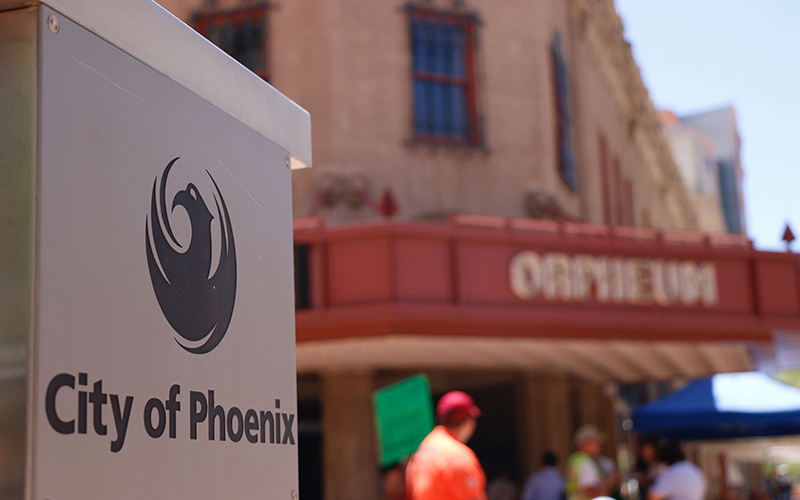
PHOENIX – The Police Department continued its rollout of body-worn cameras Wednesday, issuing the devices to about a dozen officers in the Cactus Park Precinct in north Phoenix. The department’s goal of providing body cams to 2,000 first responders by Aug. 12 now is almost halfway completed, authorities said.
At the rollout, Sgt. Kevin Johnson showed a roomful of officers how to turn on the cameras, reminding them that the blinking red light means the device is recording.
Before the officers collected their cameras and filtered out to start their shift, Johnson reminded them they must have the cameras operating during any investigation.
“We want everyone to see the great work we’re doing,” he said.

Sgt. Tommy Thompson said the focus often is on monitoring police behaviors with body-worn cameras, but the technology also allows officers to better display their side of the story.
In February, the City Council approved a $5.6 million five-year contract with Axon Enterprise of Scottsdale to provide the cameras to 2,000 officers and maintain video archives. The first body-worn cameras were issued in April in the Maryvale Estrella Mountain Precinct.
The rollout continues amid increased scrutiny on police in the wake of last month’s controversial viral video of the stop of Dravon Ames, Iesha Harper and their two young children. The video, in which police, guns drawn, are heard threatening to shoot the pair suspected of shoplifting, was criticized by many as an excessive display of force.
It became a tipping point for fury over accused police misconduct over the years and ignited passionate support from police advocates who say officers are unfairly criticized for doing tough jobs.
Thompson, at Wednesday’s rollout in north Phoenix, said many people think $5.6 million should buy a lot of cameras, but they fail to take into account such things as storage and the additional personnel needed to prepare footage for dissemination and records requests. Much of the funding is allocated for infrastructure.
The model the department selected is the Axon Body 2, but the five-year contract with Axon includes upgrades to newer models as they become available, Thompson said.
The department now has supplied cameras to 950 frontline officers — about halfway to the goal — and the rollout will be complete by Aug. 12, he said, adding that Axon has donated an additional 200 cameras.
During a special City Council meeting on Tuesday, Mayor Kate Gallego reassured the public that the city has accelerated its timetable body-cam rollout, which originally called for process to be completed by the end of the year.
Body cameras have become a focal point across the U.S. in the wake of police shootings.
At council and community meetings, Arizonans aargued that body cameras could deter misconduct and showcase good behavior in police interactions with the public.

At a council meeting last month, Xenia Orona questioned why body camera footage and police reports could not be made immediately available after police encounters.
“It should be as easy as checking a Twitter feed,” she said.
Police Chief Jeri Williams, who outlined a five-point plan at a special meeting of the council Tuesday to improve police accountability and community-police relations, pointed to body cameras as among those reforms.
“Yesterday, we started the rollout of Cactus Park Precinct and that puts us well over the 50% mark of having body-worn cameras out on patrol, Williams said at Tuesday’s council meeting. “Axon is giving us an additional 200 cameras along with the software to accompany it to make sure we are able to outfit our neighborhood enforcement teams and our community action officers.”
Phoenix has flirted with implementing body-worn cameras since a $500,000 pilot program issued the devices to officers in Maryvale in 2013.
An Arizona State University report published in 2014 analyzing the Maryvale pilot program found use of body-worn cameras reduced complaints against officers by 23%, despite only 13% to 40% of incidents being recorded.
The council on Tuesday also approved a search for contractors for early intervention software to track officer behavior and potential vendors to survey community attitudes toward the police. In both cases, the items were approved 7-1.
The council also discussed the implementation of a civilian review board to foster accountability and better community relations for the police force.
Councilman Carlos Garcia, as he had in previous council meetings, wore a T-shirt that read “End Police Brutality” and voiced his support for a civilian review board with subpoena power and disciplinary authority over officers.
“The problem is we’re the deadliest city in the country at the hands of police,” Garcia said. “That’s what’s not working.”
Councilman Jim Waring argued against the creation of a civilian review board, citing the lengthy process an officer involved in an incident must face navigating three existing boards. He noted that those boards already contain elements of public participation and was skeptical that adding another layer of scrutiny would solve anything.
“I think a lot of the folks who want us to set up this board… are also calling for the immediate firing of the officers in the current situation,” Waring said of the Ames video. “I’m not sure how those two things come together.”
The council did not take any action on implementing a civilian review board, but will reconvene in September to discuss the matter further.
